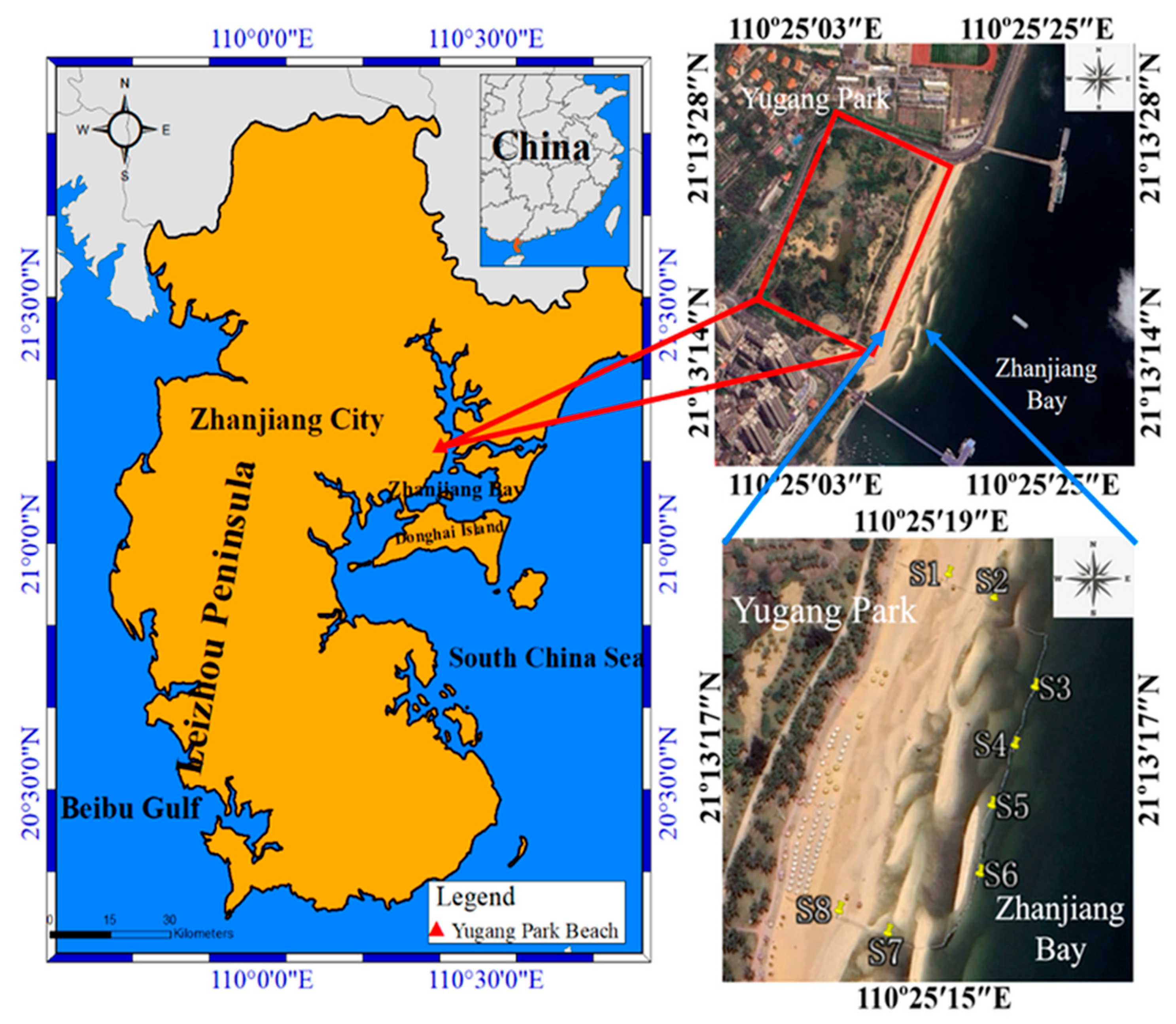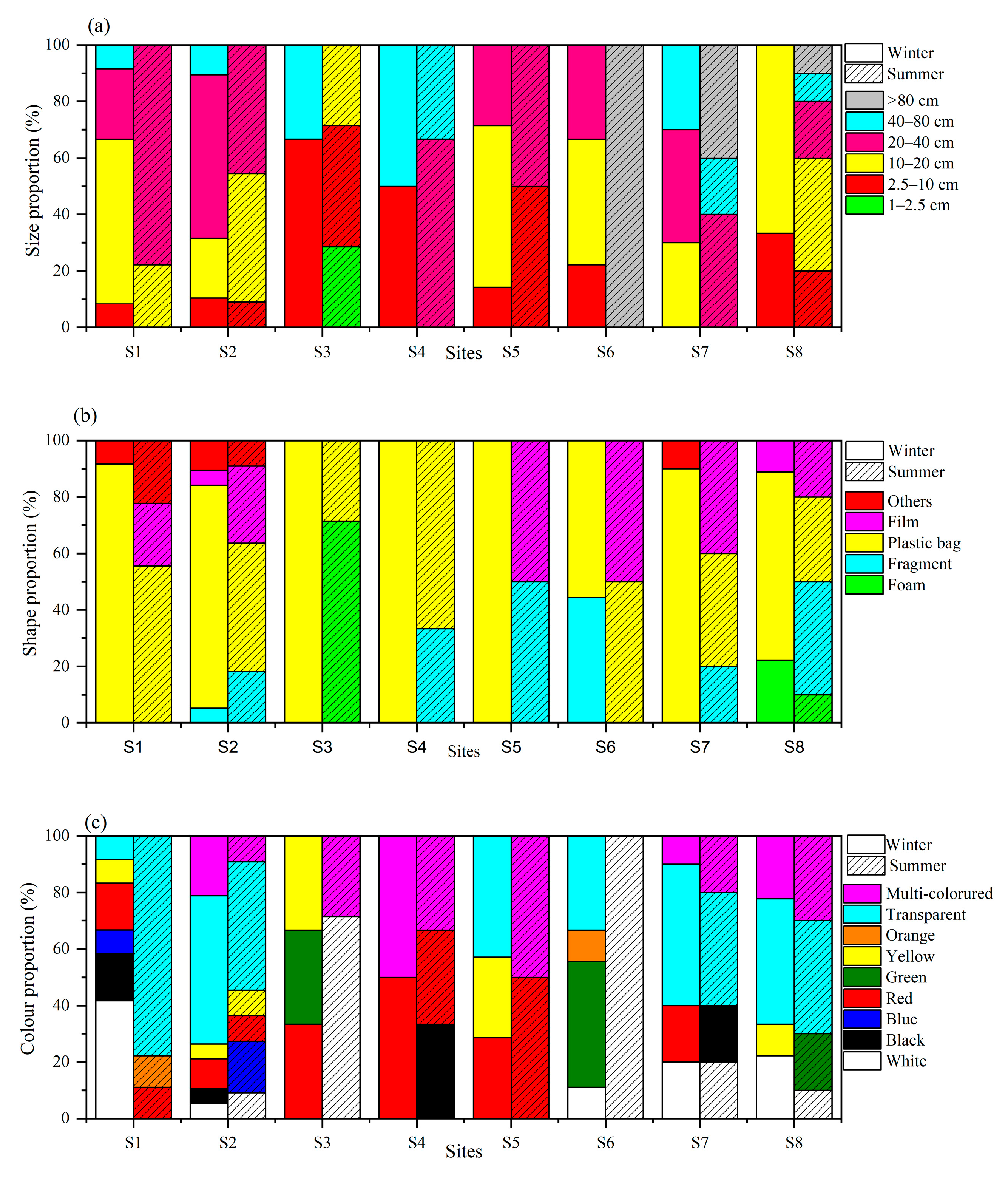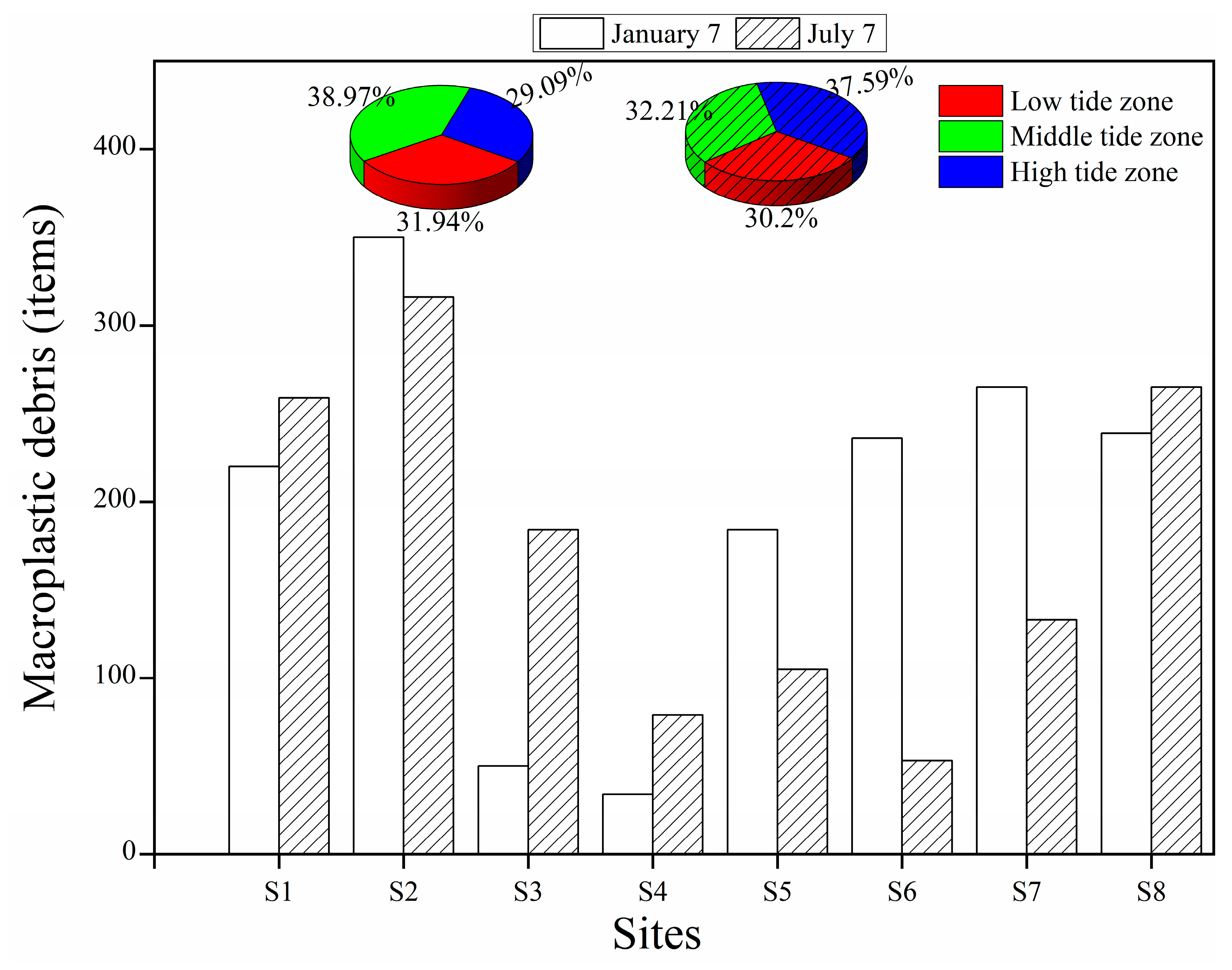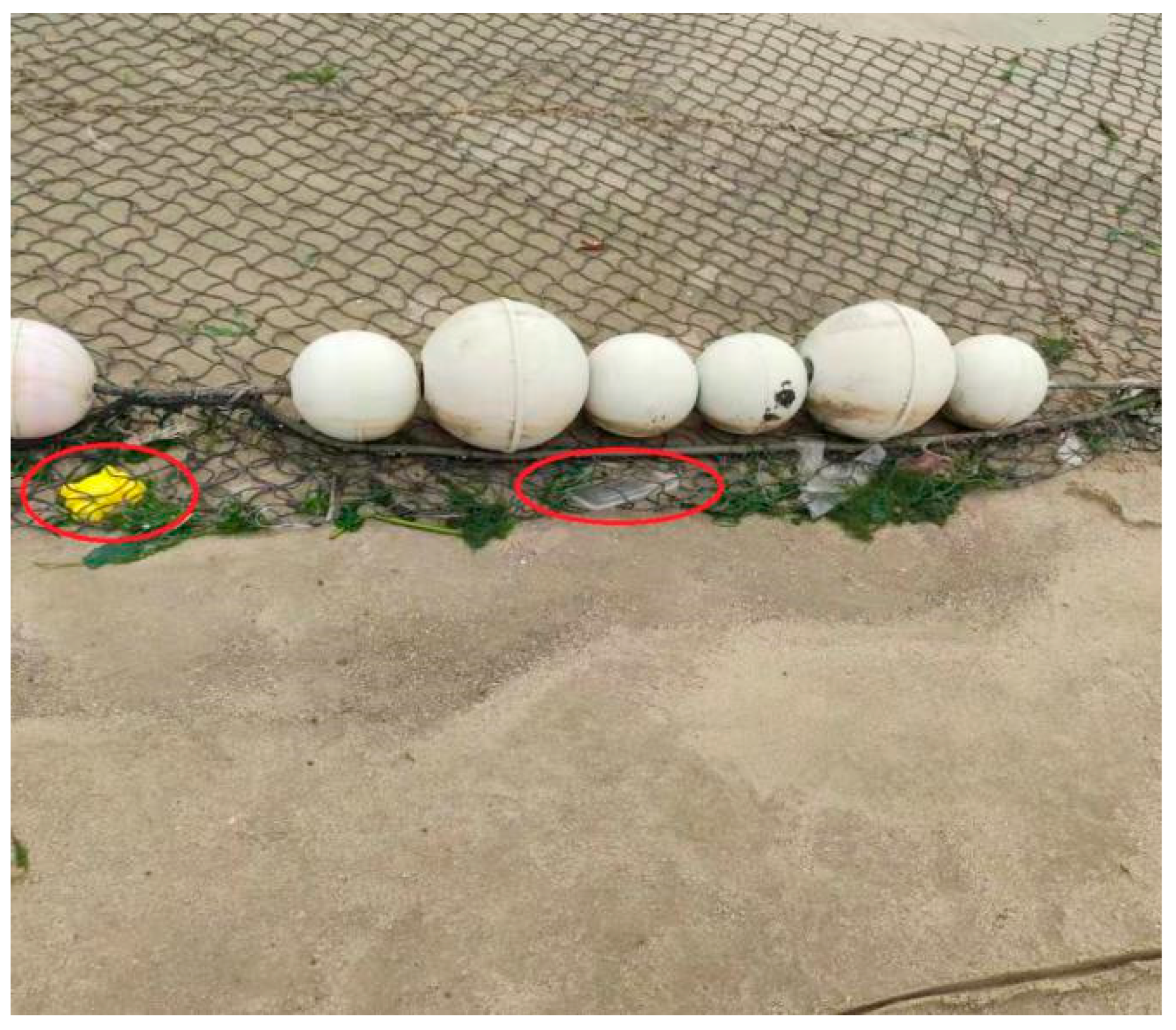Seasonal Macroplastic Distribution and Composition: Insights from Safety Nets for Coastal Management in Recreational Waters of Zhanjiang Bay, China
Abstract
1. Introduction
2. Materials and Methods
2.1. Study Area and Sampling Stations
2.2. Sample Collection
2.3. Laboratory Analysis
2.4. Quantification of Macroplastic Debris
2.5. Statistical Analysis
3. Results
3.1. Spatiotemporal Pattern of Macroplastic Debris on the SN of the YPB
3.2. Spatiotemporal Size, Colour, and Shape Composition of Macroplastic Debris on the SN of the YPB
3.3. Analysis of Typical Macroplastic Samples by Fourier Transform Infrared Spectrometer
3.4. Quantifying the Total Amount of Macroplastic Debris on the SN of the YPB
4. Discussion
4.1. Macroplastic Debris Pollution Levels on the SN of the YPB
4.2. Spatiotemporal Patterns of Macroplastic Distribution
4.3. Composition of Size, Color, and Shape of Entrapped Macroplastics
4.4. Chemical Composition Analysis of Macroplastics
4.5. Implications for Coastal Management
5. Conclusions
Author Contributions
Funding
Data Availability Statement
Acknowledgments
Conflicts of Interest
References
- Olatayo, K.I.; Mativenga, P.T.; Marnewick, A.L. Comprehensive evaluation of plastic flows and stocks in South Africa. Resour. Conserv. Recy. 2021, 170, 105567. [Google Scholar]
- Maharana, D.; Saha, M.; Dar, J.Y.; Rathore, C.; Sreepada, R.; Xu, X.-R.; Koongolla, J.B.; Li, H.-X. Assessment of plastics along the west coast of India: Abundance, distribution, polymer type and toxicity. Chemosphere 2020, 246, 125708. [Google Scholar] [PubMed]
- Jokar, Z.; Banavi, N.; Taghizadehfard, S.; Hassani, F.; Solimani, R.; Azarpira, N.; Dehghani, H.; Dezhgahi, A.; Sanati, A.M.; Farjadfard, S.; et al. Marine litter along the shores of the Persian Gulf, Iran. Heliyon 2024, 10, e30853. [Google Scholar] [CrossRef] [PubMed]
- Suaria, G.; Avio, C.G.; Mineo, A.; Lattin, G.L.; Magaldi, M.G.; Belmonte, G.; Moore, C.J.; Regoli, F.; Aliani, S. The Mediterranean plastic soup: Synthetic polymers in Mediterranean surface waters. Nat. Publ. Group 2016, 6, 37551. [Google Scholar]
- Li, Y.; Zhang, Q.; Baartman, J.; van Wijnen, J.; Beriot, N.; Kroeze, C.; Wang, M.; Xu, W.; Ma, L.; Wang, K.; et al. The Plastic Age: River pollution in China from Crop Production and Urbanization. Environ. Sci. Technol. 2023, 57, 12019–12032. [Google Scholar] [CrossRef]
- Eriksen, M.; Lebreton, L.C.M.; Carson, H.S.; Thiel, M.; Moore, C.J.; Borerro, J.C.; Reisser, J. Plastic pollution in the world’s oceans: More than 5 trillion plastic pieces weighing over 250,000 Tons a float at sea plastic pollution is ubiquitous throughout the marine environment. PLoS ONE 2014, 9, e111913. [Google Scholar]
- Allison, N.L.; Dale, A.C.; Narayanaswamy, B.E.; Turrell, W.R. Investigating local trawl fishing as a source of plastic beach litter. Mar. Pollut. Bull. 2024, 205, 116627. [Google Scholar] [CrossRef]
- Andrady, A.L. The plastic in microplastics: A review. Mar. Pollut. Bull. 2017, 119, 12–22. [Google Scholar] [CrossRef]
- Acampora, H.; Schuyler, Q.A.; Townsend, K.A.; Hardesty, B. Comparing plastic ingestion in juvenile and adult stranded short-tailed shearwaters (Puffinus tenuirostris) in eastern Australia. Mar. Pollut. Bull. 2013, 78, 63–68. [Google Scholar]
- Xiao, Z.; Yu, S.; Li, Y.; Ruan, S.; Bing, L.; Huang, Q.; Zhang, L.; Chen, X.; Tang, D. Materials Science & Engineering R Materials development and potential applications of transparent ceramics: A review. Mater. Sci. Eng. 2020, 139, 100564. [Google Scholar]
- Bradney, L.; Wijesekara, H.; Palansooriya, K.N.; Obadamudalige, N.; Bolan, N.S.; Ok, Y.S.; Rinklebe, J.; Kim, K.-H.; Kirkham, M. Particulate plastics as a vector for toxic trace-element uptake by aquatic and terrestrial organisms and human health risk. Environ. Int. 2019, 131, 104937. [Google Scholar] [CrossRef]
- GESAMP. Sources, fate and effects of microplastics in the marine environment: A global assessment. GESAMP Rep. Stud. 2016, 90, 1020–4873. [Google Scholar]
- Alvarado-Zambrano, D.; Rivera-Hernández, J.R.; Green-Ruiz, C. Macroplastic and microparticle pollution in beach sediments from Urias Coastal Lagoon (Northwest Mexico). Toxics 2024, 12, 439. [Google Scholar] [CrossRef]
- Bergmann, M.; Gutow, L.; Klages, M. Marine Anthropogenic Litter; Springer: Berlin/Heidelberg, Germany, 2015; 447p. [Google Scholar]
- Axelsson, C.; van Sebille, E. Prevention through policy: Urban macroplastic leakages to the marine environment during extreme rainfall events. Mar. Pollut. Bull. 2017, 124, 211–227. [Google Scholar] [CrossRef]
- Kasavan, S.; Yusoff, S.; Fakri, M.F.R.; Siron, R. Plastic pollution in water ecosystems: A bibliometric analysis from 2000 to 2020. J. Clean. Prod. 2021, 313, 127946. [Google Scholar] [CrossRef]
- Wu, W.; Biber, P.; Mishra, D.R.; Ghosh, S. Sea-level rise thresholds for stability of salt marshes in a riverine versus a marine-dominated estuary. Sci. Total Environ. 2020, 718, 137181. [Google Scholar]
- Yu, R.-S.; Yang, Y.-F.; Singh, S. Global analysis of marine plastics and implications of control measure strategies. Front. Mar. Sci. 2023, 10, 1305091. [Google Scholar] [CrossRef]
- Abelouah, M.R.; Ben-Haddad, M.; Alla, A.A.; Rangel-Buitrago, N. Marine litter in the central Atlantic coast of Morocco. Ocean Coast. Manag. 2021, 214, 105940. [Google Scholar] [CrossRef]
- Savoca, M.S.; Abreo, N.A.; Arias, A.H.; Baes, L.; Baini, M.; Bergami, E.; Brander, S.; Canals, M.; Choy, C.A.; Corsi, I.; et al. Monitoring plastic pollution using bioindicators: A global review and recommendations for marine environments. Environ. Sci. Adv. 2024, 4, 10–32. [Google Scholar] [CrossRef]
- Fruergaard, M.; Laursen, S.N.; Larsen, M.N.; Posth, N.R.; Niebe, K.B.; Bentzon-Tarp, A.; Svenningsen, S.K.; Lia, N.; Trinh, B.-S.; Tran-Thi, P.T.; et al. Abundance and sources of plastic debris on beaches in a plastic hotspot, Nha Trang, Viet Nam. Mar. Pollut. Bull. 2023, 186, 114394. [Google Scholar]
- Núñez, P.; Pérez-García, L.; Rezaee, S.M.; Bárcena, J.F.; García, A. Experimental study of buoyant macro- and mesoplastic trapping by Spartina maritima. Mar. Pollut. Bull. 2025, 216, 118005. [Google Scholar] [CrossRef]
- Nawarat, K.; Reyns, J.; Vousdoukas, M.I.; Duong, T.M.; Kras, E.; Ranasinghe, R. Coastal hardening and what it means for the world’s sandy beaches. Nat. Commun. 2024, 15, 10626. [Google Scholar] [CrossRef]
- Blettler, M.C.; Agustini, E.; Abrial, E.; Piacentini, R.; Garello, N.; Wantzen, K.M.; Vega, M.G.; Espinola, L.A. The challenge of reducing macroplastic pollution: Testing the effectiveness of a river boom under real environmental conditions. Sci. Total Environ. 2023, 870, 161941. [Google Scholar]
- Richon, C.; Kvale, K.; Lebreton, L.; Egger, M. Legacy oceanic plastic pollution must be addressed to mitigate possible long-term ecological impacts. Microplastics Nanoplastics 2023, 3, 25. [Google Scholar] [CrossRef]
- Leslie, H.A.; van Velzen, M.J.; Brandsma, S.H.; Vethaak, A.D.; Garcia-Vallejo, J.J.; Lamoree, M.H. Discovery and quantification of plastic particle pollution in human blood. Environ. Int. 2022, 163, 107199. [Google Scholar] [CrossRef]
- Egessa, R.; Nankabirwa, A.; Basooma, R.; Nabwire, R. Occurrence, distribution and size relationships of plastic debris along shores and sediment of northern Lake Victoria. Environ. Pollut. 2020, 257, 13442. [Google Scholar] [CrossRef]
- Wang, Z.; Zhao, H.; Zhao, L. Distribution characteristics and pollution sources analysis of polycyclic aromatic hydrocarbons and Phthalate Esters in the. Water 2024, 16, 948. [Google Scholar] [CrossRef]
- Zhang, P.; Wei, S.; Zhang, J.; Zhong, H.; Wang, S.; Jian, Q. Seasonal distribution, composition, and inventory of plastic debris on the Yugang Park Beach in Zhanjiang Bay, South China Sea. Int. J. Environ. Res. Public Health 2022, 19, 4886. [Google Scholar]
- Brewster, C.W.; Morse, M.R.; Fournier, R.J.; Joseph, L.; Baechler, B.R.; de Frond, H.; McCauley, D.J. Assessing macroplastic debris collected from eight diverse river systems across four continents: Insights from synchronous three-year community-led research efforts. J. Environ. Manag. 2025, 391, 126354. [Google Scholar]
- Anna, S.; Rozalina, C. Macroplastic distribution (Single-use plastics and some Fishing gear) from the northern to the southern Bulgarian Black Sea coast. Reg. Stud. Mar. Sci. 2020, 37, 101329. [Google Scholar] [CrossRef]
- Tramoy, R.; Ledieu, L.; Ricordel, S.; Astrié, D.; Tassin, B.; Gasperi, J. Macrolitter dataset from a highly frequented roadway in Nantes. France. Data Br. 2022, 42, 108237. [Google Scholar]
- Garello, N.; Blettler, M.C.; Espínola, L.A.; Wantzen, K.M.; Gonz’alez-Fern’, D.; Rodrigues, S. The role of hydrodynamic fluctuations and wind intensity on the distribution of plastic debris on the sandy beaches of Paran’a River, Argentina. Environ. Pollut. 2021, 291, 118168. [Google Scholar] [PubMed]
- de Deus, B.C.T.; Costa, T.C.; Altomari, L.N.; Brovini, E.M.; de Brito, P.S.D.; Cardoso, S.J. Coastal plastic pollution: A global perspective. Mar. Pollut. Bull. 2024, 203, 116478. [Google Scholar] [CrossRef]
- Tavares, D.C.; Moura, J.F.; Ceesay, A.; Merico, A. Density and composition of surface and buried plastic debris in beaches of Senega. Sci. Total Environ. 2020, 737, 139633. [Google Scholar]
- Gündoğdu, S.; Çevik, C. Mediterranean dirty edge: High level of meso and macroplastics pollution on the Turkish coast. Environ. Pollut. 2019, 255, 113351. [Google Scholar] [CrossRef]
- Kurniawan, R.; Saputra, I.A.; Purnomo, H. Composition of macroplastics in Teluk Penyu, Cilacap. AACL Bioflux 2024, 17, 1499–1509. [Google Scholar]
- Markić, A.; Iveša, N.; Budiša, A.; Kovačić, I.; Burić, P.; Pustijanac, E.; Buršić, M.; Banai, B.; Legin, D.P.; Palatinus, A.; et al. Fragmented marine plastics as the prevalent litter type on a small island beach in the Adriatic. Mar. Pollut. Bull. 2024, 203, 116467. [Google Scholar] [CrossRef]
- Balthazar-Silva, D.; Turra, A.; Moreira, F.T.; Camargo, R.M.; Oliveira, A.L.; Barbosa, L.; Gorman, D. Rainfall and tidal cycle regulate seasonal inputs of microplastic pellets to Sandy Beaches. Front. Environ. Sci. 2020, 8, 123. [Google Scholar] [CrossRef]
- Wu, X.; Zhao, X.; Chen, R.; Liu, P.; Liang, W.; Wang, J.; Shi, D.; Teng, M.; Wang, X.; Gao, S. Size-dependent long-term weathering converting floating polypropylene macro- and microplastics into nanoplastics in coastal seawater environments. Water Res. 2023, 242, 120165. [Google Scholar] [PubMed]






| Geographical Area | Period | Plastic Size | Abundance | Reference | |
|---|---|---|---|---|---|
| N° Item (m2) | Weight (g·m−2) | ||||
| Beaches of Paran’a River (Argentina) | Autumn (2018) | macroplastic | 0.8 ± 0.2 | 9.96 ± 2.6 | [33] |
| Winter (2018) | 0.70 ± 0.3 | 8.82 ± 1.1 | |||
| Spring (2018) | 1.79 ± 0.5 | 26.09 ± 6.9 | |||
| Summer (2019) | 0.36 ± 0.2 | 4.89 ± 0.6 | |||
| River Veleka mouth (The Bulgarian Black Sea coast) | Summer (-) | macroplastic | 0.12 | - | [31] |
| Channel 2-Varna (The Bulgarian Black Sea coast) | - | macroplastic | 3.40 | - | |
| All China Beach Area | 2020 | Beach trash | 0.22 | 1.24 | [34] |
| Fishing landing beaches in northern Lake Victoria | July, October (2018) | macroplastic | 18.1 | - | [27] |
| Recreational beaches in northern Lake Victoria | 3.8 | - | |||
| Beaches in in Senegal, West Africa | Feburary (2019) | plastic debris (>5 mm) | 1.92 | - | [35] |
| Iskenderun Bay, Turkey | 13th May | macroplastic | 12.3 | 0.80 | [36] |
| Yugang Park Beach, Zhanjiang Bay, China | Summer survey (2021) | macroplastic | 1.59 | 14.22 | This study |
| Winter survey (2021) | 1.81 | 14.21 | |||
Disclaimer/Publisher’s Note: The statements, opinions and data contained in all publications are solely those of the individual author(s) and contributor(s) and not of MDPI and/or the editor(s). MDPI and/or the editor(s) disclaim responsibility for any injury to people or property resulting from any ideas, methods, instructions or products referred to in the content. |
© 2025 by the authors. Licensee MDPI, Basel, Switzerland. This article is an open access article distributed under the terms and conditions of the Creative Commons Attribution (CC BY) license (https://creativecommons.org/licenses/by/4.0/).
Share and Cite
Sembiring, C.B.; Zhang, P.; Xu, J.; Ke, S.; Zhang, J. Seasonal Macroplastic Distribution and Composition: Insights from Safety Nets for Coastal Management in Recreational Waters of Zhanjiang Bay, China. Oceans 2025, 6, 64. https://doi.org/10.3390/oceans6040064
Sembiring CB, Zhang P, Xu J, Ke S, Zhang J. Seasonal Macroplastic Distribution and Composition: Insights from Safety Nets for Coastal Management in Recreational Waters of Zhanjiang Bay, China. Oceans. 2025; 6(4):64. https://doi.org/10.3390/oceans6040064
Chicago/Turabian StyleSembiring, Chairunnisa Br, Peng Zhang, Jintian Xu, Sheng Ke, and Jibiao Zhang. 2025. "Seasonal Macroplastic Distribution and Composition: Insights from Safety Nets for Coastal Management in Recreational Waters of Zhanjiang Bay, China" Oceans 6, no. 4: 64. https://doi.org/10.3390/oceans6040064
APA StyleSembiring, C. B., Zhang, P., Xu, J., Ke, S., & Zhang, J. (2025). Seasonal Macroplastic Distribution and Composition: Insights from Safety Nets for Coastal Management in Recreational Waters of Zhanjiang Bay, China. Oceans, 6(4), 64. https://doi.org/10.3390/oceans6040064






